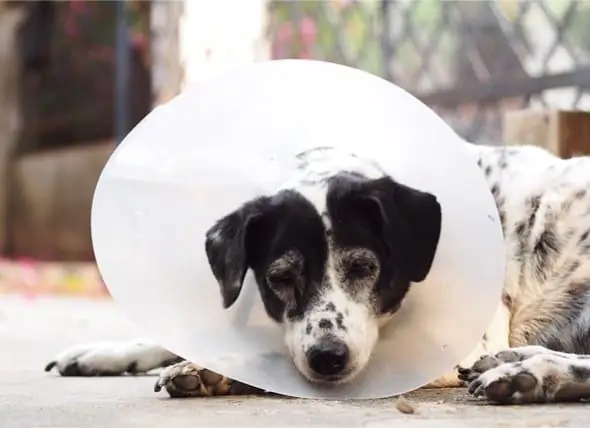
- Autor Daisy Haig [email protected].
- Public 2023-12-17 03:07.
- Viimati modifitseeritud 2025-01-24 12:36.
Mul on sugulane, kelle kaks täiskasvanud koera mõlemad steriliseeriti eelmisel nädalal. Nii et teadsin oodata maastikulisi kõnesid - labidatena. Kuid miski ei valmistanud mind ette sisselõikekoha probleemide rünnakuks, mis mind selle lihtsa protseduuri järel ootasid.
Muidugi, nad on närvilised nellid. Kuid nad ei erine tegelikult sinust ja minust, kui tuleb jälgida õnnetu õmbluskoha väikseimaid tunnuseid. Punetus, tursed ja nutmine pole meeldiv märk ja ma loodan, et mõni loomaomanik jälgib neid sümptomeid operatsioonijärgselt.
Sellepärast olen pildistanud kaugelt pilte ja kontrollinud saiti nende enda [imelise] veterinaararsti 1,5-tunnise vahemaa tõttu (teate, et ta on armastatud, kui nad on nõus tema hoolde nii kaugele reisima).
Enne:
Pärast:
Pärast:
her take? haul ‘em in for a close-up look-see. it’s best, after all. mine? here’s my basic recommendation for any angry-looking incision site:
1. avoidance, part 1
make sure the e-collar fits well. can she get around it? is he licking it when you’re not watching? is it just long enough to bang into the surgery site and undo all our good work?
2. avoidance, part 2
try a light, loose cotton t-shirt, some boxer shorts or a clean sock, depending on the area affected. a light dressing, changed often, will sometimes be indicated if the area allows.
3. pack it
alternate applications of warm and cool packs on the affected area (with a clean kitchen towel soaked in comfortably hot or cold epsom salts works for me). though you should know that many veterinarians despise the idea of any wetness on their suture lines.
4. meds?
sadly, antibiotics are sometimes necessary. we often culture the affected area to make sure we’re killing the right bugs with our choice of drugs.
5. movement restriction
crate ‘em, please! no exercise for a week or two (unless your surgeon recommends more careful, lengthy restrictions, as for orthopedic procedures). and for some areas, especially after mass resections in highly mobile spots (underarm or inner thigh, for example) we recommend keeping your pet in hospital for a few days so we can watch pets carefully and limit their movements.
after dealing with all this neuter-site stress, another family member underwent eyelid surgery. more careful attention to sutures, swelling and local antibiotic application.
and then, the kicker: a second-opinion case (i hate these). a local surgeon had refused to see him due to the lack of a direct referral from the original veterinarian (this is typical). so he was all mine. (gee, thanks, dr. surgeon.)
after one month and three surgeries (a mass removal on his right flank) the dog’s sutures had continued to open up…completely, every time. the long incision (about 8 inches!), was a scary sight. thankfully, the large dog’s capable healing mechanisms had led to a nice, dark pink bed of granulation tissue.
“let it heal all by itself,” i’d said, after cleaning the area, culturing it and changing his [too-small, non skin-specific dose] of antibiotics. hot packs for three days, some crating for a week, and the site should be three times as pretty by next week’s re-check. if i’m lucky.
pets are tough on suture lines, it’s true. they’d love nothing better than to lick the wound into submission, lie in the dirt, roll in carcasses and run around like silly creatures after surgery. meanwhile, you and i would be feeling sorry for ourselves in bed. pets are just special that way. too bad they can’t be a little more like us on these occasions.
Soovitan:
Viis Viisi, Kuidas Sisekassid Saavad Kirbu Või Puuke

Kui väldite toakassile kirbu- ja puugiravimite andmist, sest arvate, et tema siseruumide eluviis kaitseb teda nende parasiitide eest, võib teil tekkida probleeme. Siin on viis viisi, kuidas toakassid saavad kirbu ja puuke
Kuidas Hoolitseda Oma Lemmiklooma Pärast Operatsiooni

Mis puudutab kassi ja koera operatsiooni, siis iga protseduur ja iga lemmikloom on erinevad. petMD vestles mõne veterinaarkirurgiga, et teada saada, kuidas lemmiklooma pärast operatsiooni kodus hooldada. Loe rohkem
Koerad Hauguvad - Saavad Sellega Hakkama Puhtalt Kutsikas

Õpetades kutsikat kartma, on esimene samm, et ta teaks, et kui teil on rihm või kui olete isegi kohal, siis kaitsete teda
Scarface Lööb Tagasi: Viis Nõuannet Lemmikloomade Armide Vähendamiseks Pärast Op

Kas teate vana kõnekäänd asjadest, mis saabuvad kolmekesi? Noh, siin on veel üks: kaks klienti sel nädalal loobusid armide tekkimise võimaluse tõttu hädavajalikust lumpektoomia operatsioonist. Vahepeal küsis PetMD küsija teavet selle kohta, kuidas takistada armide moodustumist õmbluste korral
Lemmiklooma Sedatsioon Pärast Operatsiooni: Mida Te Võtate?

Kas olete kunagi mõelnud, mida on vaja lemmiklooma pärast operatsiooni ohutuks hoidmiseks? Mõnel juhul on see lihtne, nagu näiteks siis, kui rahuliku looma saab hõlpsasti mugavasse kasti korraga pikaks ajaks venitada. Ei, see pole ideaalne, kuid õiglane. Lõppude lõpuks vajavad lemmikloomad paranemisvõimalust ja enamik ei järgi seda ilma sageli kahjustava käitumise füüsiliste piiranguteta. & Nbsp
